
In classical physics a point mass moving in one dimensional space usually gets depicted in a space time diagram. Below you see three examples (red, green, blue) in the center graph. Depending on the direction and the speed for a free particle in a system without forces (pool ball without collision) you get a straight line.
The same information is depicted in phase space, (the space of position and momentum ) by a vertical line: The momentum (speed) remains constant while space changes (left graph).

Another example is the classical one-dimensional harmonic oscillator for instance a point mass attached to a spring that moves back and forth along the x-axis. In the space time diagram its motion will be depicted by a sine wave x(t) (center graph above). The same information in phase space results in a circle: High speed at center position, speed zero at maximum extension (left graph above). You can see the alternation of kinetic and potential energy.
In both cases the state of the point mass is completely characterized by a point in phase space.
Now figuratively these concepts can be translated directly into the quantum world, we will only have to take into account the probabilistic nature of all entities at the quantum level.
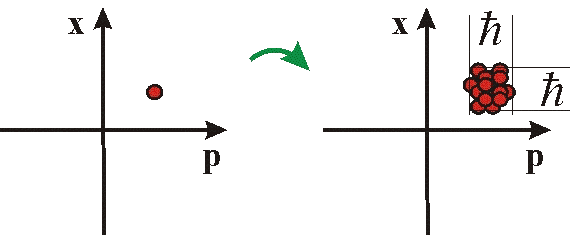
Due to its quantum nature the electric field of a freely propagating light wave carries
some intrinsic
quantum noise.
This can be understood by
Heisenberg's
uncertainty relation,
The operators of
phase-
and
amplitude-
quadrature of the light field do not commute, similar to
position and momentum of a particle. Just as we cannot measure a particle's
position and momentum simultaneously with
arbitrary precision, the same applies to phase and amplitude of a light wave:
the more precisely the phase of a light wave is measured, the less
determined becomes its ampitude and vice versa. The product of phase- and
amplitude-uncertainty has a fixed lower limit. States of the light field with the smallest
possible amount of overall quantum noise are called minimum uncertainty states. An example for such
a state is the
coherent state.
This is the state of the light field which resembles
most closely our notion of a classical sinusoidally propagating light wave, the classical
harmonic oscillator described above (ref.1).
The amount of its quantum noise is distributed evenly in time, i.e.
it is the same for any phase angle of the wave.
The coherent state is the state that is emitted by an ideal
laser.
The reason for
this is the following:
As a simple model of a laser you can think of a box containing the light field in the ground state. If the electrical field inside the box
is now pushed from time to time by an external force (optical or electrical pumping),
quantum mechanical
perturbation theory
will tell you that after a certain time the state of the light field inside the
box will be most likely a coherent state (ref.2).
Shown below is the measurement of the quantum
noise of a coherent state's electrical field in dependance of its phase angle (= time).
It is a sine wave broadened by the amount of its quantum noise.

The amount of a coherent state's quantum noise is
not only independent of the wave's phase, but also
of its amplitude. Thus with increasing amplitude the overall amount of quantum noise remains the
same. However the relative signal to noise ratio (regarding the light wave itself as the
signal) becomes better. This is one of the reasons why quantum effects of the light field
become more or less unobservable for classical light waves, that is waves with large
amplitudes. For such waves the influence of the very small amount of quantum noise
is negligible in most cases. Shown below are the measurements of three laser waves with increasing
amplitudes (notice the different scaling of the y-axis in units of the vacuum noise of the
light field).
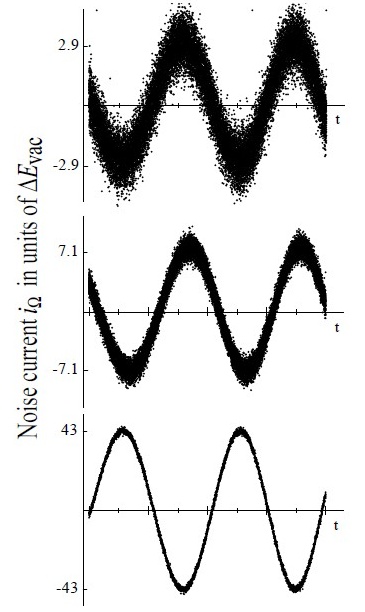
Notice that when the amplitude goes to zero the noise still remains there.
This is the
vacuum noise
of the light's electrical field, corresponding to the mysterious
1/2 energy quantum that we met in the harmonic oscillator lessons in our first quantum mechanics
classes. It corresponds to an intrinsic non-extractable field energy of a system without
any excitation.
The
probability distribution
of the quantum noise at each phase angle is gained, by
sampling the measured noise amplitude values. An example is shown in the next graph.
The noise figure to the left represents a small section of one of the measurements shown
above corresponding to a specific phase angle, the bins at the right form the
corresponding field distribution function (rotated by 90°). In the case of a coherent
state the resulting distribution can be fitted by a
Gaussian
(red line).
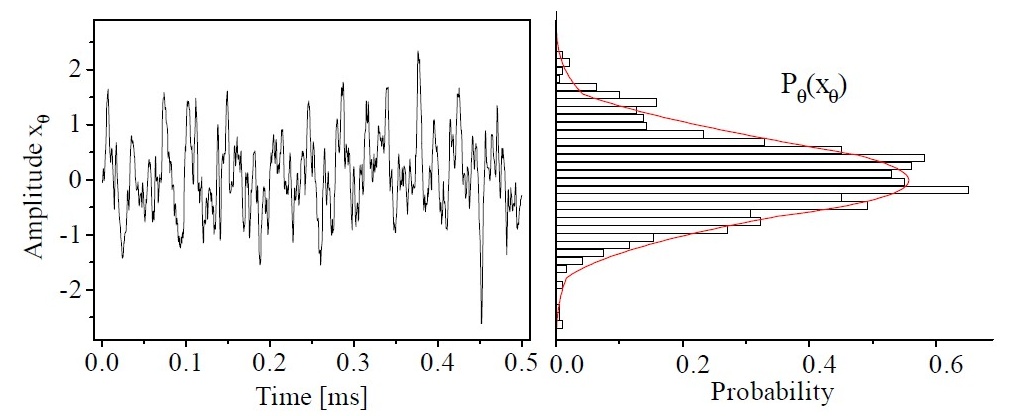
This probability distribution of the quantum noise at a certain time (=
phase angle) corresponds to the state's wave packet, known from
Schroedinger's description of quantum mechanics.
Sampling the quantum noise at a whole series of time intervals, we
obtain the wave packet at different times, thus we can observe the time evolution of the
state's wave packet. The coherent state's wave packet oscillates evenly back and forth,
similar to the movement of a classical particle within an harmonic potential. Unlike a
classical particle however, there will be always a certain width of the wave packet, an
uncertainty in its exact position. For a coherent state this width remains always the same
throughout the whole oscillation period. This was the first example of quantum dynamics
found by
E. Schroedinger
in 1926 (ref.1).
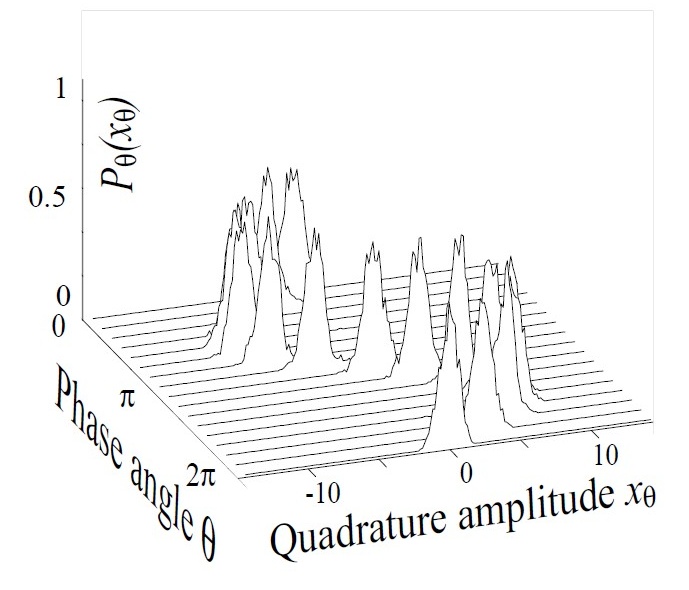
Most instructively and compact the state of the light field is depicted by
its
Wigner function.
This function was found by
L. Szilard
and
E.P. Wigner
some years before 1932 for "another purpose". The Wigner function is a phase space distribution similar
to the
Maxwell-Boltzmann distribution
of position and momentum of an ensemble of particles
known from classical statistical mechanics. It is not a probability distribution though,
since due to the non-commutativity of position and momentum (i.e. phase- and
amplitude-quadrature in the case of the light field) it may take on negative values. The
wave packet is the density projection of the Wigner function distribution under various
phase angles. Thus, measuring the wave packets probability distribution for a set of phase
angles between 0 and pi as shown above, corresponds figuratively speaking to looking at
the (non-measurable) Wigner function from different directions. The Wigner function can be
gained from these experimental noise measurements via
tomographical reconstruction techniques,
inverse transformations similar to the ones applied in medical imaging (ref.3,4).
First measurements of this kind were done in the group of Prof. Raymer in
Oregon (ref.9).
Looking at the illustration below you see that you can regard Schroedinger's wave
packet either as a furtive glance at the unmeasurable Wigner function at one specific moment, or as the
statistical distribution of a series of measurements of the elusive quantum object (the light wave) in
one specific time interval i.e. at one specific phase angle.

The coherent state's Wigner function is rotationally symmetric, due to the
phase-independence of its quantum noise. It is displaced from the origin by the amount of
the state's amplitude. Shown below is the Wigner function gained from the measured wave
packet distributions shown above.
( x0 and xp/2
denote the phase and amplitude quadrature, the ripples are due to the measurement process)
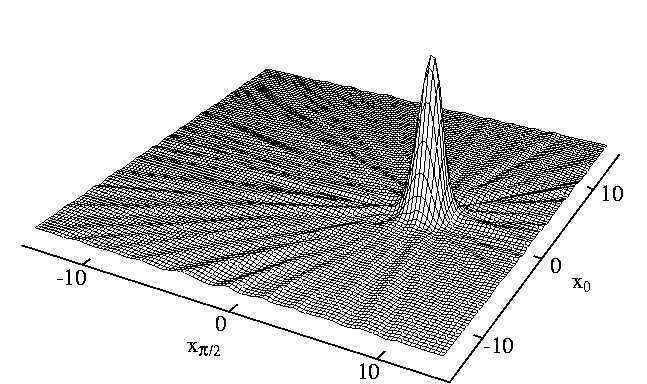
![]()